Draniki, also known as Deruny or Latkes, are a favorite comfort food. Draniki are potato fritters made from whole grated potatoes and fried until golden brown. Serve these with a dollop of sour cream or lime crema, or with apple sauce like traditional latkes.
This is a great budget-friendly recipe recipe that's perfect for a savory breakfast, for lunch, or as a starter or side dish for dinner. Basically, give me all the draniki, all day, every day!

Long food blogger post alert: I wrote a lot about draniki below because it's a favorite family recipe from the time we lived in Ukraine and still is a favorite 30 years later. If you don't want to read the personal stories, feel free to jump ahead in the table of contents.
Jump to:
- Tasty fried draniki
- Draniki vs Deruny vs Russian Potato Fritters vs Latkes
- What kind of potatoes to use for draniki
- Do you need to peel potatoes for draniki?
- How to grate potatoes for draniki
- How to turn grated potatoes from turning brown
- What kind of oil to use for cooking draniki
- Can you air fry draniki?
- Glute-free draniki
- Ingredients
- Instructions
- What to serve with draniki
- See more traditional recipes we enjoyed in Ukraine
- Draniki (Deruny or Potato Fritters)
- Reviews
Tasty fried draniki
We LOVE this recipe because it has such a basic, comfort food flavor thanks to using just a few ingredients (grated potatoes, onion, egg, a tiny bit of flour). The layered texture of grated raw potatoes fried in oil is like no other—it is hard to describe but it's so so good! It's almost like the texture of tater tots or hash browns, but not quite the same.
They're so good and definitely worth trying if you've never had them!
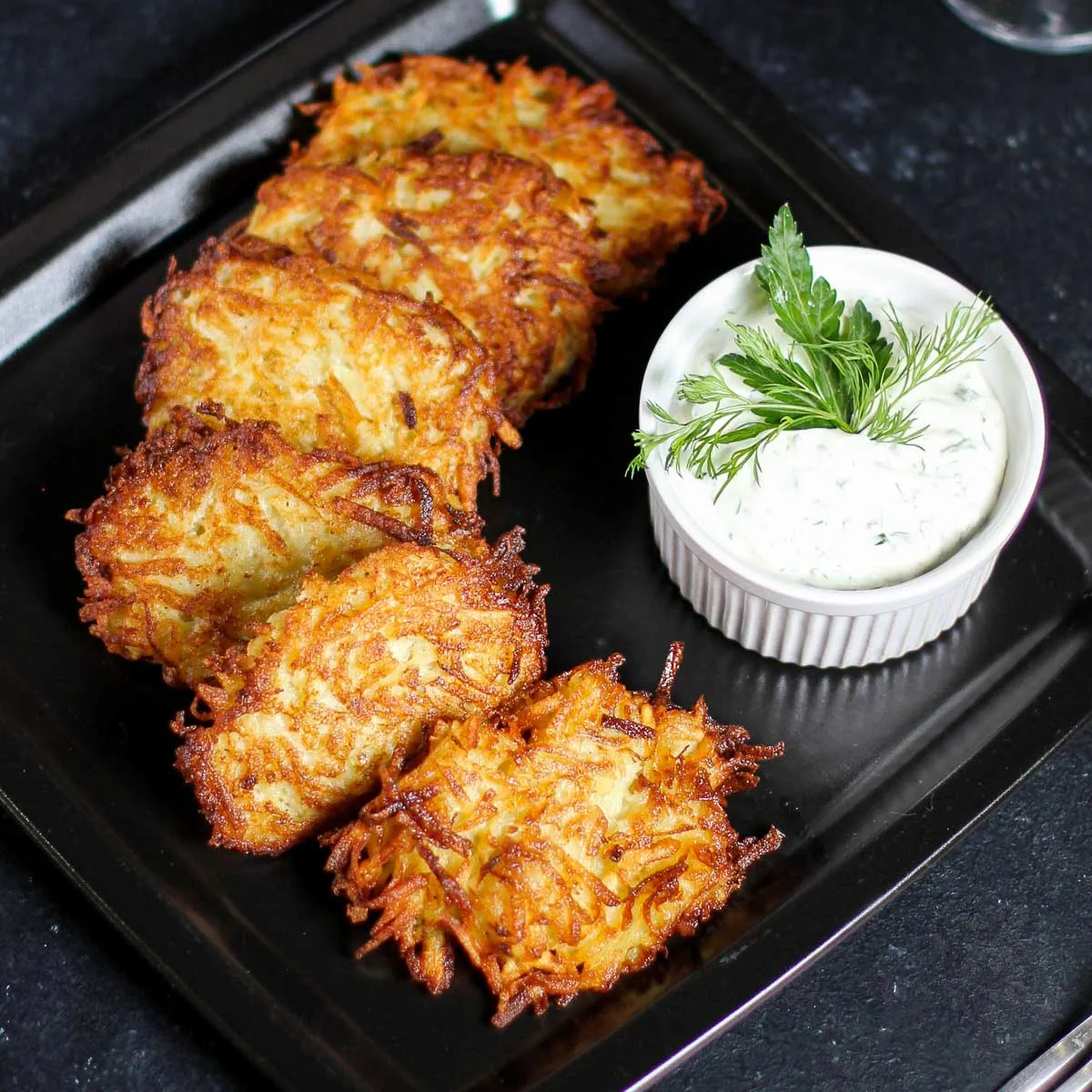
Draniki are pan-fried in just enough oil to make them crispy and golden brown (without burning them), but not as much oil as deep-frying.
They're best served warm just a few minutes after being cooked, and I have special memories of waiting around in the kitchen for my mom or grandma to finish cooked the next batch of draniki so I can grab a hot and fresh one... even if I slightly burned the tips of my fingers or my tongue!
Related recipe: Mashed Potato Fritters (these are quite different than draniki because they're made from cooked mashed potatoes)
Draniki vs Deruny vs Russian Potato Fritters vs Latkes
All these four names refer to the same dish: Grated potatoes fried in oil.
Draniki is the Russian word for these potato fritters. Deruny is the Ukrainian word. Latkes is the Yiddish word. "Potato Fritters" is the description of the recipe in English, so you can explain to your family and friends the delicious dish you're serving them!
Keep in mind that the words "Draniki" and Deruny" is already plural, so there is no need to say "Dranikis" and "Deruny" when referred to these. Kind of like how "Varnishki" is already plural.
My family made these in Ukraine and called them Draniki, since we spoke Russian in Ukraine during the Soviet Union. When we make these to celebrate Chanukkah, we call them Latkes. It's very confusing being an Eastern European Jewish immigrant, I tell ya!
Just like all traditional recipes, there are SO MANY DIFFERENT WAYS to make draniki. Some people make them without flour, some people chop the onion and fry it separately instead of grating it, some people add other seasonings in addition to salt and pepper. Some people even make them from boiled grated potatoes instead of from raw grated potatoes.
Traditionally, many Ukrainian and Russian people don't cook with a lot of spices and seasonings. Salt, pepper, onions, plus a few fresh herbs is what goes into most foods.
As usual, I give you the basic draniki recipe below and add a few suggestions for what other additions or seasonings would go well in this recipe.
Related recipe: Sweet Potato Latkes
What kind of potatoes to use for draniki
I prefer using Yukon Gold potatoes because they have a thin peel and I find them easy to grate. Any other kind of potatoes, such as russet, will work too. After all, when we lived in Ukraine/Russia we did not have the luxury of choosing types of potatoes.
A potato was a potato. End of story. We made draniki with whatever kind of potatoes were available.
Related recipe: Sautéed Potatoes with Mushrooms
Do you need to peel potatoes for draniki?
It is a personal preference whether to peel potatoes for draniki or to leave the peels on. If the potatoes are scrubbed clean, you can leave the peels on and grate the potato with the skin on.
I prefer to leave the skin on because of all the nutrients in the skin, and also because you really don't notice it in the final dish because draniki have these wonderful layers of grated potatoes.
Related recipe: Roasted Young Potatoes with Crispy Skins
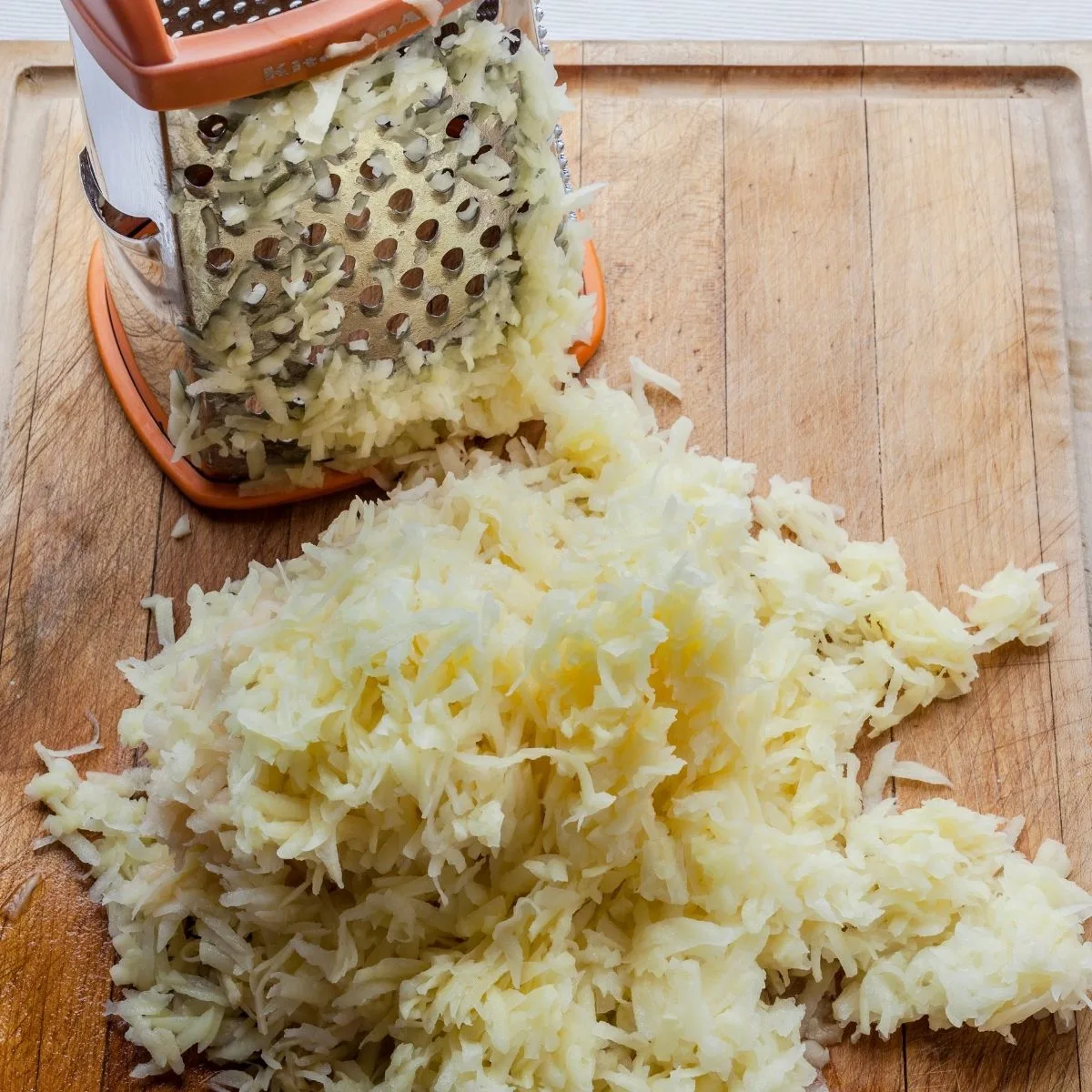
How to grate potatoes for draniki
The most basic way to grate potatoes for draniki is to use the side with the coarse grater on a box grater. Hold the box grater steady with one hand over a large non-slip cutting board. Make sure to wear cut-resistant kitchen gloves so you don't accidentally cut your finger with the grater.
I have to admit that it is a little hard to grate 3 large potatoes to make draniki. I typically have to stop a few times and take a few seconds break because my forearm gets tired. If you have a food processor with a grater attachment or a rotary cheese grater, then it is DEFINITELY worth getting it dirty. If I ever double this draniki recipe I always get my rotary cheese grater out.
For this recipe, I grate the onion on the grater along with the potatoes. This is the fastest way to prep an onion for draniki since you already have the grater out, and also gets a subtle onion flavor into the draniki.
No chopping + lots of flavor?? That sounds like a win-win!
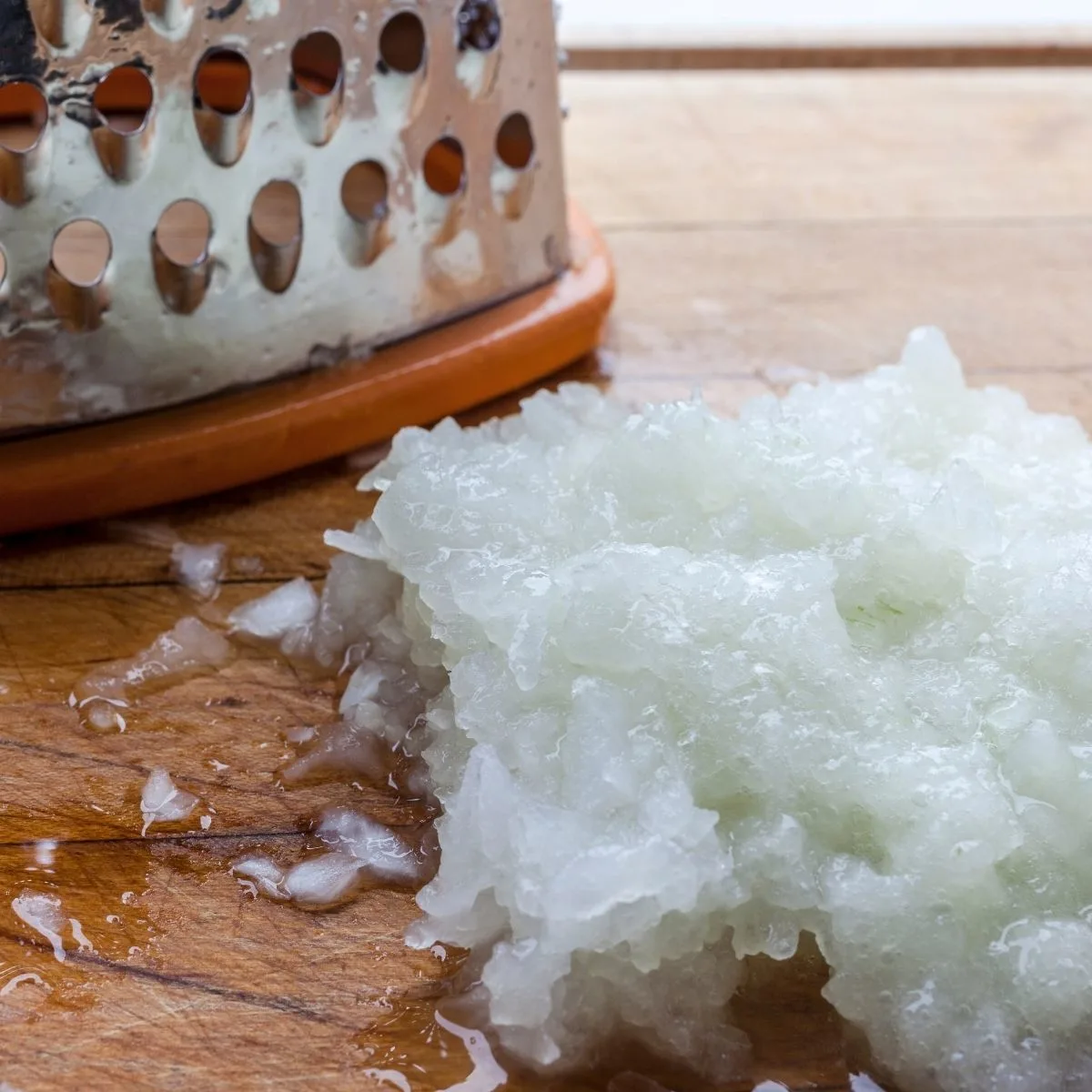
Related recipe: Russian Grated Beet Salad
How to turn grated potatoes from turning brown
Potatoes oxidize and turn a grey-brown color when exposed to air. One trick I learned recently for baking draniki without having them turn grey-brown is to sprinkle in a tiny bit of lemon juice into the grated potatoes and mix everything together. The lemon juice prevents potatoes from turning brown.
This recipe calls for 3 large potatoes and 1 tablespoon (3 teaspoons) of lemon juice. After grating each potato, I sprinkle in about 1 teaspoon lemon juice and give it a quick stir.
Don't worry, the draniki don't taste sour or lemony. You will squeeze out most of the lemon juice, along with the extra potato juices, before cooking draniki.
Related recipe: Zucchini Fritters
What kind of oil to use for cooking draniki
Traditionally, sunflower oil was used for frying and cooking in Ukraine and the parts of Russia that my family was from. Any kind of cooking oil can be used for draniki: olive oil, vegetable oil, grapeseed oil, sunflower oil, corn oil, or even coconut oil works fine in this recipe.
I prefer the flavor of olive oil. Sunflower oil would be a close second for me.
More potato recipes to try: Za'atar Roasted Potatoes
Can you air fry draniki?
Draniki can be air fried, but the texture of air-fried draniki is not as good as pan-fried draniki. They puff up in the air fryer and the edges get a little too burned for my liking in the time that it takes to cook the draniki through in the air fryer. Sure, it's a perfectly passable option if you're trying to reduce the oil and calories, but it's not as good as pan-frying.
But since we eat draniki as an occasional treat, I prefer to pan-fry them in oil. The beauty of pan-frying them is that you press down on the draniki with your spatula to flatten them, making them cook faster and more evenly.
Air frying draniki doesn't even really save you any time because it takes about 12-15 minutes at 350F (this may vary depending on your specific air fryer), while it takes about 5 minutes to fry 4-5 draniki in a large pan. You can cook a whole batch of draniki in a pan during the time it takes you to air fry one batch. You also need to brush or spray the tops of the draniki with oil before air frying, otherwise they burn on top.
If you're making draniki for the first time, I recommend pan-frying them, just so you get an idea of how they're supposed to taste before you go playing around with different recipe variations.
Glute-free draniki
I like to add a little flour to draniki to help absorb extra liquid, which makes the draniki crispier, tastier, and easy to cook. If you need gluten-free draniki, just use ¼ cup of your favorite 1:1 gluten-free flour substitute.
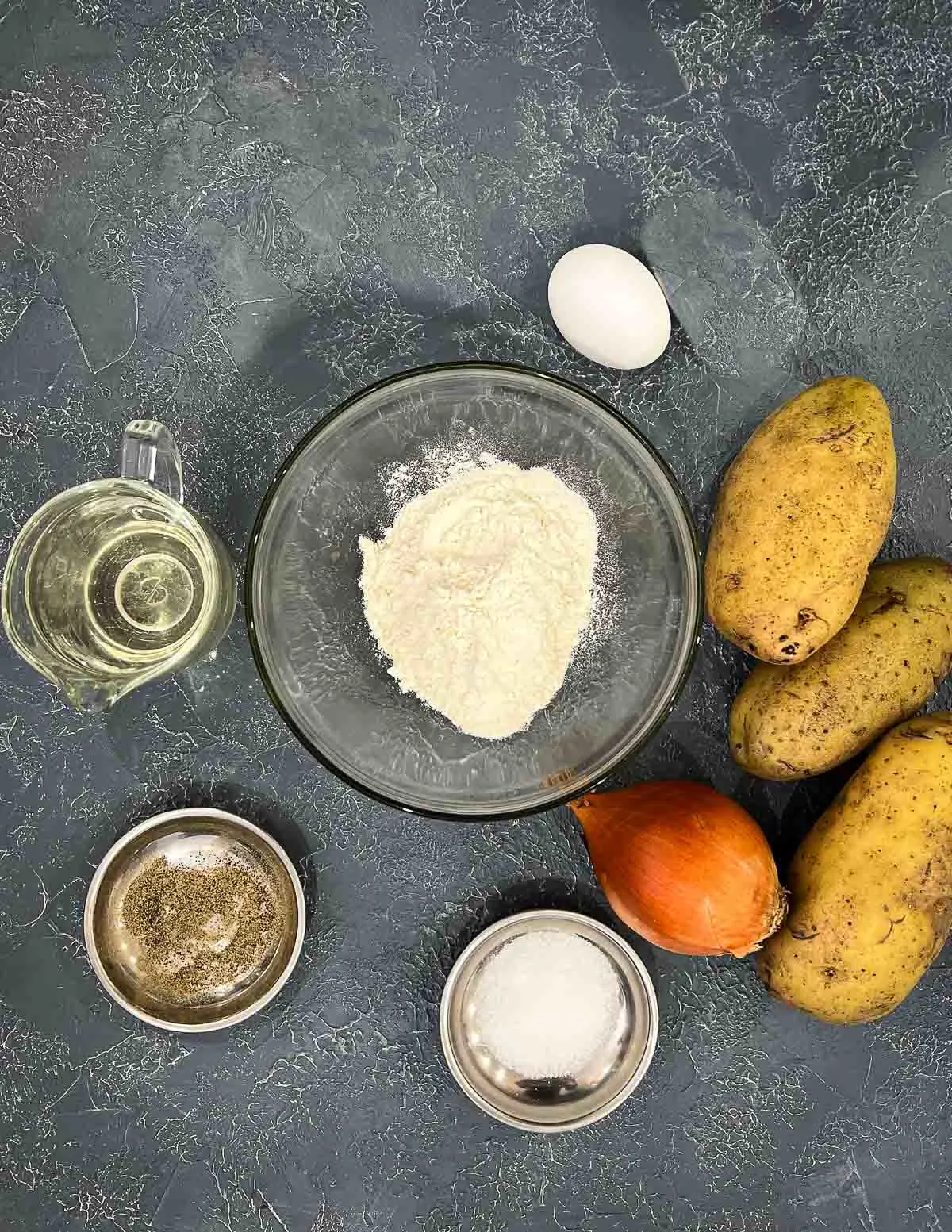
Ingredients
For the draniki:
- 3 large potatoes (1.5 lb total) - I like Yukon gold - scrubbed clean
- 1 small yellow onion
- 1 tablespoon lemon juice (this can be bottled or fresh)
- 1 egg
- ~¾ - 1 teaspoon salt, or to taste (use up to ~1.5 teaspoon salt for salty draniki)
- ~¾ teaspoon ground pepper, or to taste
- ¼ cup all-purpose flour (use gluten-free 1 to 1 flour, if needed)
- ~4-8 tablespoons olive oil for cooking (or any vegetable oil)
Feel free to add ½ teaspoon garlic powder, paprika, and/or cumin to add some more spices to the mixture.
For the sour cream:
- ½ cup sour cream
- 1 teaspoon lemon juice or lime juice
- 1 pinch garlic powder
- 1-2 pinches salt
- Optional: ~1 tablespoon fresh chopped herbs, such as dill, parsley, or green onion/chives
Equipment needed:
- Box grater (or other kitchen tool with a grater setting)
- Large metal colander
- Large bowl
- Large nonstick pan
Instructions
Step 1: Use the large grater on a box grater to grate the potatoes and the onion, and transfer everything to a large bowl. Drizzle with a few drops of lemon juice after every potato and mix together. This will help prevent the grated potatoes from browning.
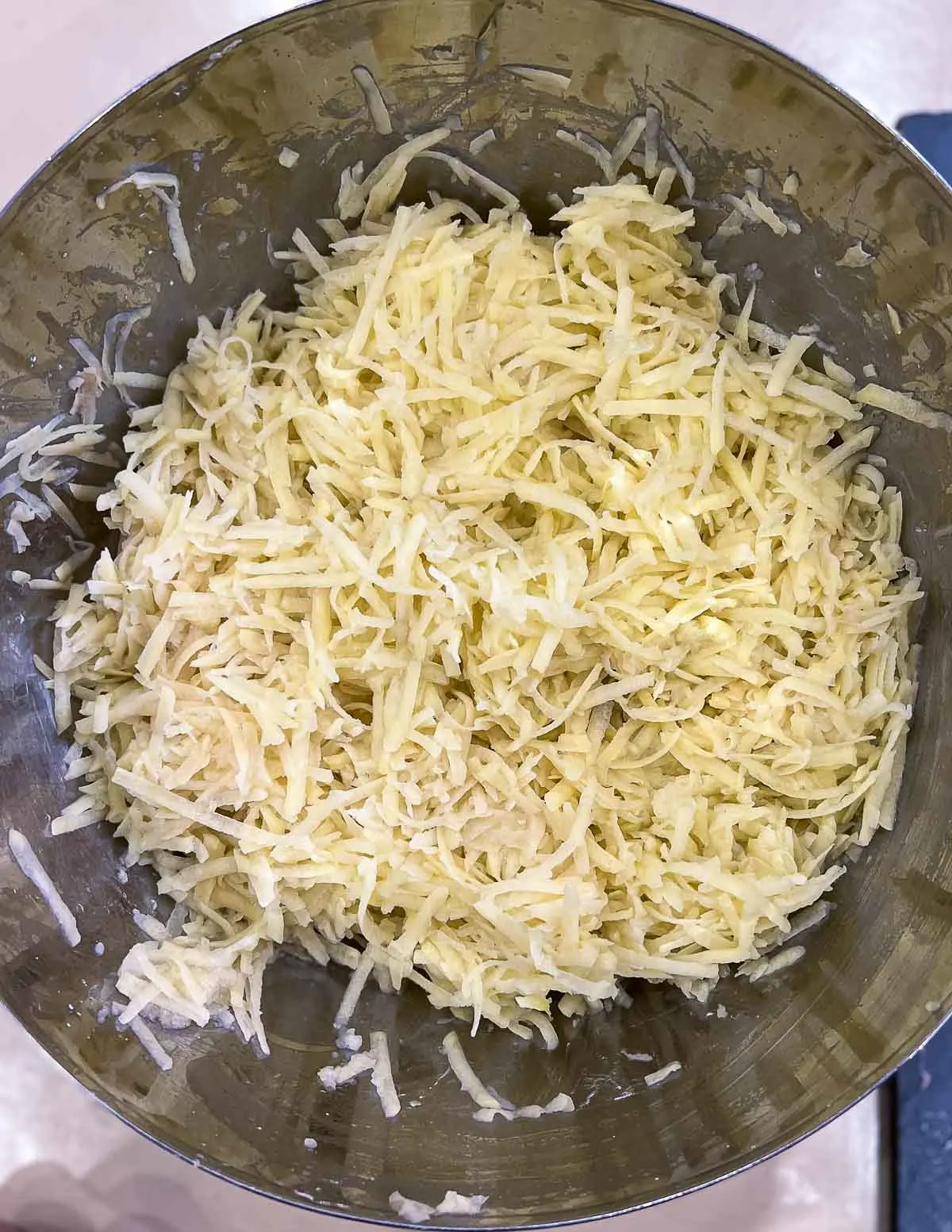
Step 2: Transfer the potato and onion mixture to a colander and use your hands to squeeze out as much liquid as you can. No need to go crazy here, but the mixture shouldn't be dripping wet. This will get rid of the extra lemon juice and and liquid and will help make these draniki perfectly tasty.
Step 3: Transfer the grated potato mixture back to the same bowl and stir in the egg, salt, and pepper. Add the flour and mix well. The mixture will be just a little goopy, and that's OK.
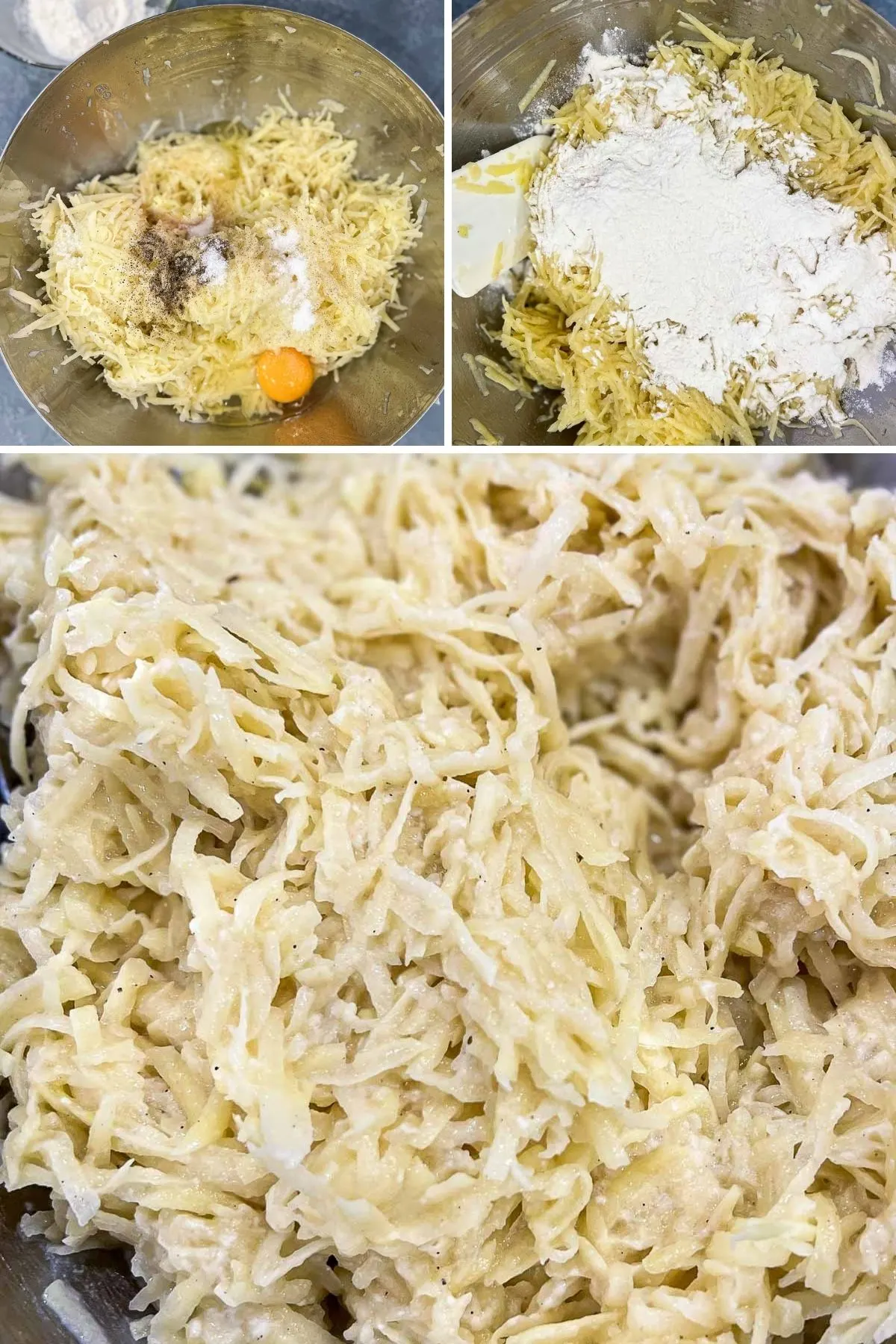
Step 4: Heat a large skillet. I like to cook in 2 skillets at a time to make this go faster, but I don't recommend doing that until you get the hang of cooking these in one skillet, as they take a few attempts to get the heat just right. They cook fast, just like pancakes!
Add ~1-2 tablespoons of olive oil to the pan. The pan should not be completely covered in olive oil, but you'll want enough oil to make sure that the edges of the draniki are sizzling in oil if you're cooking ~4-6 draniki at a time. Carefully place a large rounded tablespoon of the draniki mixture into the hot pan and use the back of the spoon to gently press down. Cook over medium-low heat for 2-3 minutes, or until the bottom is golden brown. Use a spatula to carefully flip the draniki, press down again to flatten the draniki, and cook on the other side for 2-3 minutes, or until golden brown.
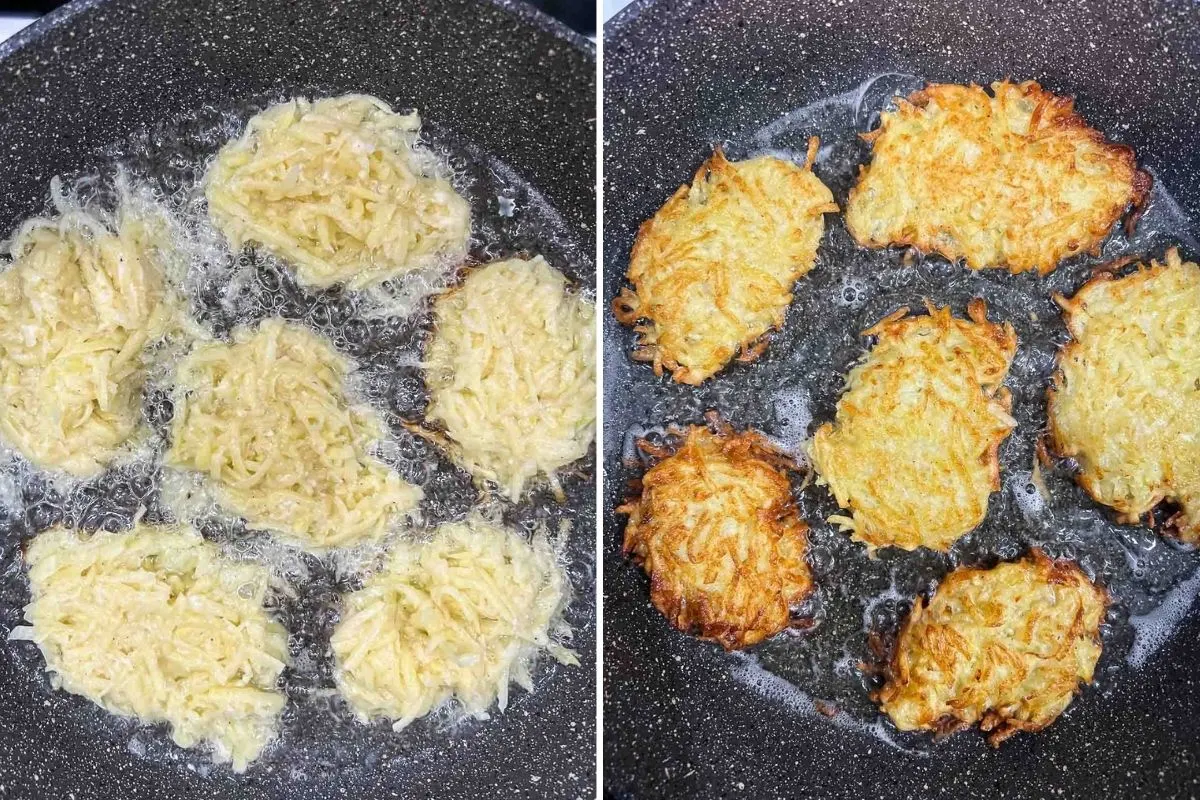
Remove from the pan and place on a large plate lined with paper towels to absorb excess oil.
Step 5: Serve warm with a dollop of sour cream or flavored sour cream. To make the flavored sour cream, combine all the ingredients together and adjust to taste with salt or lemon/lime juice.
What to serve with draniki
Ukrainian and Russian people typically eat these with generous amounts of sour cream spread on top. It is also common to serve these with apple sauce, which is a traditional way to serve latkes for Chanukkah.
Draniki are definitely not a light food: they're pure carbs and fat. So I recommend either enjoying a few on their own for lunch, or serving them as your side dish for dinner instead of potatoes or other starch, or to have a side salad with them if you're trying to keep it healthy.
If dietary considerations are not an issue, then draniki are great served alongside pretty much any protein: chicken, fried fish, steak, stew.
Let me know how you like these!
See more traditional recipes we enjoyed in Ukraine
- Syrniki (Farmer's Cheese Pancakes)
- Zapekanka (Farmer's Cheese Cheesecake)
- Pan-Fried Cauliflower
- Golubtsi (Stuffed Cabbage)
- Sautéed Cabbage and Kielbasa
- Wafer Cake (No-Bake 3 Ingredient Dessert!)
If you enjoyed this recipe, let me know with a comment and a star rating below. And don't forget to share it on Facebook and save it on Pinterest for later!
Draniki (Deruny or Potato Fritters)
Ingredients
- 3 large potatoes - (1.5 lb total) - I like Yukon gold - scrubbed clean
- 1 small yellow onion
- 1 tablespoon lemon juice - (bottled or fresh)
- 1 egg
- ¾ - 1 teaspoon salt - or to taste (use up to ~1.5 teaspoon for salty draniki)
- ¾ - 1 teaspoon ground pepper - or to taste
- ¼ cup all-purpose flour
- 4-8 tablespoons olive oil - (or any vegetable oil) for cooking
- ½ cup sour cream
- 1 teaspoon lemon juice or lime juice
- 1 pinch garlic powder
- 1-2 pinches salt
- Optional: ~1 tablespoon fresh chopped herbs, such as dill, parsley, or green onion/chives
Special equipment
- Box grater (or other kitchen tool with a grater setting)
Instructions
- Use the large grater on a box grater to grate the potatoes and the onion, and transfer everything to a large bowl. Drizzle with a few drops of lemon juice after every potato and mix together. This will help prevent the grated potatoes from browning.
- Transfer the potato and onion mixture to a colander and use your hands to squeeze out as much liquid as you can. No need to go crazy here, but the mixture shouldn't be dripping wet.
- Transfer the grated potato mixture back to the same bowl and stir in the egg, salt, and pepper. Add the flour and mix well. The mixture will be just a little goopy, and that's OK.
- Heat a large skillet. Add ~1-2 tablespoons of olive oil to the hot pan. The pan should not be completely covered in olive oil, but you'll want enough oil to make sure that the edges of the draniki are sizzling in oil if you're cooking 4-6 draniki at a time.
- Carefully place a large rounded tablespoon of the draniki mixture into the hot pan and use the back of the spoon or a spatula to gently press down. Cook over medium-low heat for 2-3 minutes, or until the bottom is golden brown. Use a spatula to carefully flip the draniki, press down again to flatten the draniki, and cook on the other side for 2-3 minutes, or until golden brown.
- Remove from the pan and place on a large plate lined with paper towels to absorb excess oil.
- Serve warm with a dollop of sour cream or flavored sour cream. To make the flavored sour cream, combine all the ingredients together and adjust to taste with salt or lemon/lime juice.
Notes
Nutrition
The nutritional information displayed is an estimate and not to be used as dietary or nutritional advice. Consult a nutritionist or dietician for nutritional info based on the exact ingredients you use.

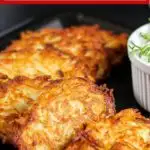
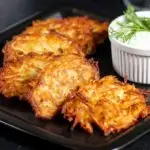
Katya
Thursday 18th of May 2023
Draniki is a Belarusian word and national dish, also sometimes named Dzeruny in southern Belarus (and Deruny in Ukraine), in Russia those are just called potato pancakes. So your family used the Belarusian name, not Russian for this dish. And being a Belarusian - it’s important for me to mention that :)
Kate
Thursday 18th of May 2023
Thanks for the clarification! My family has always called them Draniki. They've moved around a lot all over Russia and Ukraine during and after the war and are also Jewish, so I am curious where they picked up that name for these potato pancakes. - Katya :)